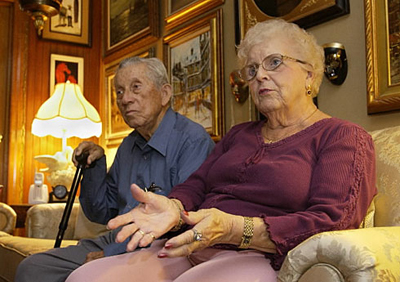MELBOURNE, Fla. — After six major hurricanes in
2004-05, rates for homeowners insurance in Florida have skyrocketed.
Homeowners, especially those in coastal counties, from Miami to Pensacola want fast relief from soaring bills, and many of them say insurance is the top issue in the Nov. 7 elections.
insurance bill for a 2,000-square-foot house has jumped from $1,604 to $5,521 in the past year. "It's the biggest problem we have in this state." Republican Gov. Jeb Bush and industry executives plan to wait until a special legislative session after the election to consider changes. It's unclear what solutions the Legislature might consider. Despite the storms in 2004 and 2005, the property and casualty insurance industry apparently is sound. As a news release from the Florida Insurance Council, a Tallahassee lobbying group, put it: "The state's hurricane insurance market remains strong and viable — in stark contrast to the shakeup that occurred a decade earlier," after Hurricane Andrew. The rate controversy also was intensified by a last-minute change this spring to an insurance bill. It says insurers who take on Florida's hurricane risks are due a "reasonable rate of return that is commensurate with that risk," but "reasonable" was not defined. State Farm Florida, the state's largest private insurer, quickly filed for a 79% rate increase, stating that it wanted a 15% profit. "In fact, we believe that due to the riskiness of State Farm Florida operating in a state like Florida, an even larger underwriting profit ... would be reasonable and not excessive," company actuary Robert Kelley wrote to regulators. State Farm won a 52.7% rate increase — a statewide average that meant bills could double or triple in coastal counties. Hurricane risk accounts for one-fifth of State Farm policyholders' new premiums, reported Steve Alexander, an actuary for the state's insurance consumer-advocate's office. Two-thirds goes to profit and commissions, he found. Companies also blame rate increases on higher costs for backup policies, or "reinsurance," they buy mostly from unregulated firms in Bermuda or Europe to pay storm claims. Some Florida insurers, such as State Farm Florida and Nationwide Insurance of Florida, have paid hundreds of millions of dollars in reinsurance premiums to their parent companies, money they list in Florida as an expense, regulatory filings and analysts' reports show. Meanwhile, Reginaldo and Lotte Lopez of Indian Harbour Beach must decide whether they can stay in the 1,500-square-foot home where they have lived since 1965. The annual State Farm insurance bill for their house, which is a mile from the Atlantic, rose from a $2,200 premium with a $2,000 deductible in 2005 to a $5,600 premium with a $5,000 deductible this year. They say they can't afford it, but no other company sells insurance in their neighborhood. Since State Farm has not dropped the Lopezes' coverage, they are not eligible for the state wind-pool coverage, which is state-backed insurance. Even if State Farm did drop them and they picked up state coverage, the state is required to charge the highest rate in the area so as not to compete with private insurers. "If we had to leave because of insurance ... it would be very hard," Lotte Lopez said. If they do not pay the increased premium, their mortgage could go into default. It's the same across Florida, according to a Mason-Dixon Poll. The poll was commissioned by newspapers in Melbourne, Fort Myers, Tallahassee and Pensacola. The newspapers are owned by Gannett Co., as is USA TODAY. The poll surveyed 625 Florida registered voters Oct. 3-5 and has a margin of error of +/—4 percentage points. It found: •42% of voters say their premiums have increased by more than $1,000 since 2005. •Nearly one in five Florida voters have considered leaving the state because of the cost of insurance. •Eight out of 10 voters said insurance premiums are very important or somewhat important in the upcoming election. Both major-party candidates for governor, Republican Attorney General Charlie Crist and Democratic U.S. Rep. Jim Davis, have responded with tough talk in the final weeks of the campaign. Crist wants to stop national insurers from creating Florida subsidiaries only for their home policies. He says that has allowed insurers to seek rate increases after storms while their parent companies reap big profits on other lines of insurance in Florida. Davis is pushing a plan to convert a state catastrophe fund into a non-profit reinsurance pool and put the state in charge of paying most hurricane claims. For their part, insurance executives are preparing for the special legislative session. Government's first priority should be to help residents weatherproof their homes with storm shutters and roofs that are brought up to code, said Gary Landry of the Florida Insurance Council, an industry lobbying group in Tallahassee. "No one wants to pay a dollar more than they have to," Landry said. "But it's part of the cost of living where we live." |
